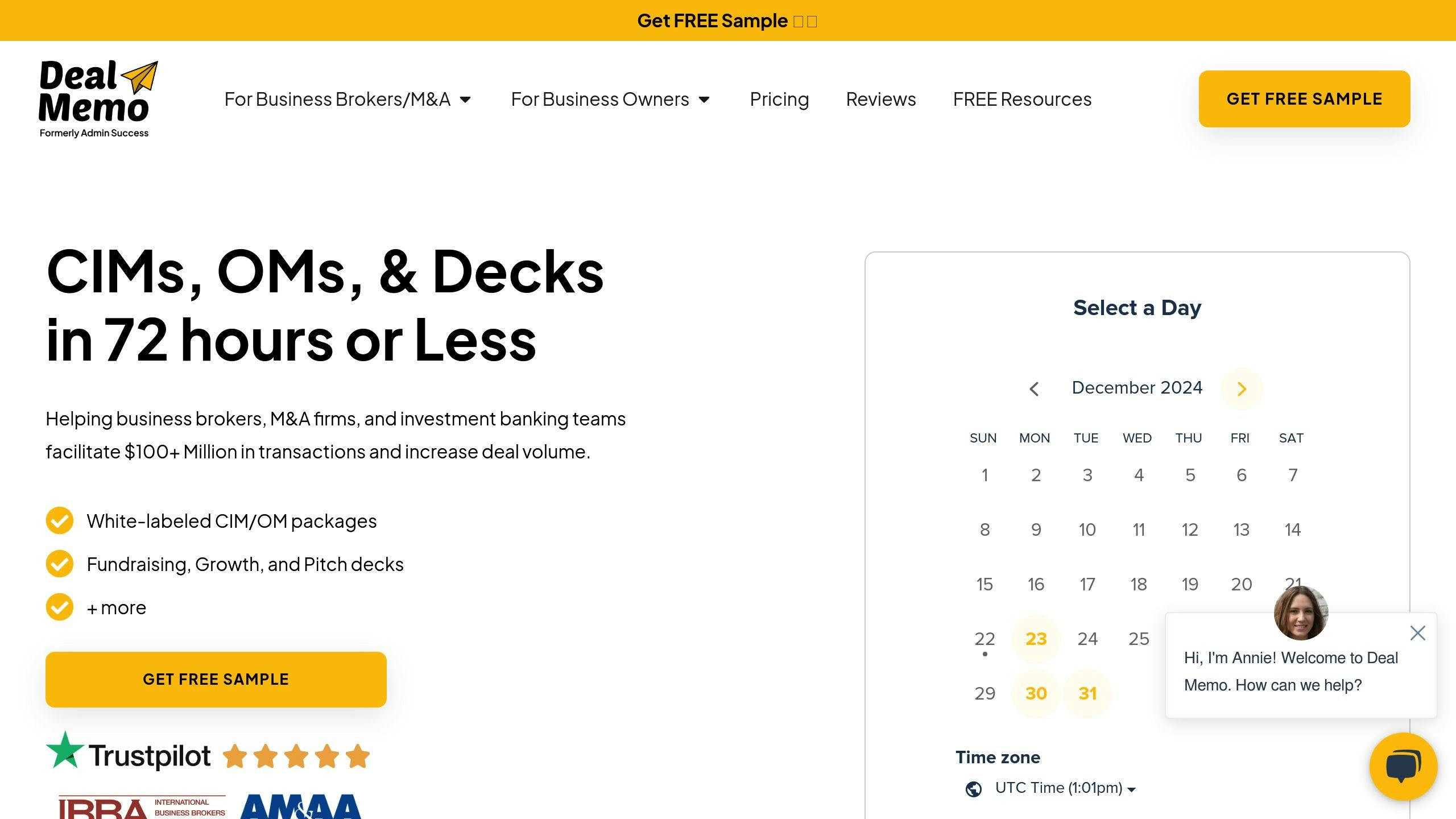Buyers look for specific metrics and growth potential when evaluating businesses in Confidential Information Memorandums (CIMs). These key value drivers fall into three main categories: financial health, market position, and growth opportunities. Here’s a quick summary:
- Financial Health: Buyers prioritize revenue growth (aiming for double-digit annual increases), EBITDA margins (>20%), and strong cash flow. Diversified revenue streams and manageable debt levels (Debt/EBITDA < 3.0x) are critical.
- Market Position: Companies with >15% market share, stable recurring revenue, and competitive advantages (e.g., proprietary assets) often secure higher valuations.
- Growth Potential: Buyers value businesses with scalable operations, clear expansion strategies, and innovation (e.g., >25% revenue from new products).
Quick Snapshot of What Buyers Want:
| Category | Key Metrics | Target Benchmarks |
|---|---|---|
| Financial Health | Revenue growth, EBITDA, cash flow | Double-digit growth, EBITDA > 20% |
| Market Position | Market share, customer retention | >15% share, retention > 90% |
| Growth Opportunities | Scalability, innovation, ROI potential | Revenue CAGR > 10%, ROI-focused plans |
Why it matters: A well-structured CIM highlights these drivers with clear data, visuals (e.g., charts), and tailored insights for buyers. This ensures a strong first impression and aligns with their priorities.
Key Value Drivers
Financial Metrics Examined by Buyers
Financial metrics are a key focus for buyers when evaluating a business. These numbers provide insight into stability, growth potential, and overall financial health.
Revenue and Profit Analysis
Buyers pay close attention to revenue trends and profitability to gauge the business’s stability and potential for growth. They typically look for double-digit year-over-year growth rates and a track record of steady growth over 3-5 years. Another critical factor is revenue diversification – buyers prefer businesses where no single customer contributes more than 10% of the total revenue.
Profit margins are another area of focus. Buyers analyze gross margins (aiming for over 40%), operating margins (over 15%), and net profitability, comparing these figures against industry standards.
EBITDA and Cash Flow Evaluation
EBITDA plays a major role in determining valuation multiples, making it a key metric for buyers. Cash flow is equally important, with buyers examining three main areas:
- Free cash flow, ideally exceeding 80% of EBITDA.
- The sustainability of operating cash flow.
- Efficiency in cash conversion, often measured through metrics like Days Sales Outstanding (DSO) and Days Inventory Outstanding (DIO).
Debt and Working Capital Assessment
A company’s capital structure provides insights into its financial resilience. Buyers evaluate debt levels, looking for:
- A Debt/EBITDA ratio below 3.0x.
- Interest coverage exceeding 3.0x.
- Debt-to-equity ratios that align with industry norms.
Working capital health is another important factor. Buyers assess this using the working capital ratio, ideally between 1.2 and 2.0, and by analyzing the cash cycle through metrics such as:
- Days Sales Outstanding (DSO): How quickly receivables are collected.
- Days Inventory Outstanding (DIO): How efficiently inventory is managed.
- Days Payables Outstanding (DPO): How the company handles its payables timeline.
Market Position and Competitive Strengths
A company’s standing in the market and its competitive edge play a major role in attracting buyer interest and determining valuation multiples. Businesses with dominant positions often secure a 12-14% premium in M&A deals [1], making these aspects key components in any CIM.
Market Share and Industry Position
Market leadership is a top priority for buyers. Companies with more than 15% market share often achieve valuation premiums in the 12-14% range. Here are some key benchmarks:
| Metric | Description | Target Benchmark |
|---|---|---|
| Market Share | Percentage of total market revenue | >15% in primary segments |
| Growth Rate | Company growth vs. industry average | 1.5x industry average |
| Market Ranking | Position among competitors | Top 3 in core segments |
Achieving these benchmarks not only boosts valuation but also strengthens competitive barriers.
Unique Selling Propositions and Barriers
Companies with strong competitive barriers enjoy EBITDA multiples that are 2.5x higher than those with weaker positions [2]. To stand out, CIMs should emphasize long-term advantages like:
- Proprietary assets, network effects, operational scale, and regulatory benefits.
Use quantifiable data to illustrate how these factors protect market share and ensure revenue stability. Highlight specific examples showing how these barriers deter competitors or maintain pricing power.
Customer Base and Diversification
Customer diversification is another critical factor in valuation stability. Buyers focus heavily on recurring revenue and retention rates as signs of business resilience.
Key metrics to showcase include:
- Retention rates: Aim for rates above 90%.
- Sector distribution: Ensure no single sector accounts for more than 30%.
- Geographic reach: Operate in at least three regions.
Strengthen your case with real-world examples, such as case studies that highlight long-term customer relationships and operational efficiencies. These examples should align with buyer priorities, particularly ROI expectations.
Growth Opportunities and Scalability
Buyers often focus on future growth potential when evaluating companies, emphasizing three key areas for expansion:
Market Expansion Potential
To grow market share, businesses need clear strategies and measurable outcomes. Here are some key metrics:
| Strategy | Key Metric | Target |
|---|---|---|
| Geographic Growth | Market entry success rate | Over 75% in new regions |
| Market Penetration | Share in existing markets | Annual growth exceeding 15% |
| Adjacent Markets | Revenue from new segments | More than 20% within 24 months |
Comprehensive Information Memorandums (CIMs) should outline detailed plans for expansion. These plans should be backed by past successes and thorough market analysis to support growth forecasts.
Innovation and Product Development
Innovation plays a critical role in driving value. Here’s how it impacts valuation:
| Innovation Metric | Industry Standard | Impact on Valuation |
|---|---|---|
| New Product Launch Success | Over 65% success rate | Adds a 15% premium |
| Time to Market | 25% faster than industry average | Adds a 10% premium |
| New Product Revenue | Over 25% from products under 3 years old | Adds a 20% premium |
Businesses should highlight a strong pipeline for product development, emphasizing their ability to align with market demand. Standardized and scalable processes for production or service delivery are essential to meet growing customer needs efficiently.
Strengthening Customer Retention: Cross-Selling Opportunities
Existing customers present a cost-effective way to grow. Focus areas include:
- Customer Lifetime Value (CLV): A proven track record of increasing the long-term value of each customer.
- Product Penetration Rate: The percentage of customers using multiple company offerings.
- Average Revenue Per User (ARPU): Consistent growth in customer spending over time.
Companies should leverage historical data to show their ability to expand customer relationships systematically while maintaining strong profitability. Repeatable processes and reliable patterns of success are key indicators of scalability.
sbb-itb-798d089
Effective Presentation of Value Drivers in CIMs
Organizing CIMs for Clarity
The way a CIM is structured plays a big role in how well potential buyers grasp the key value drivers. A clear layout makes it easier for buyers to find and understand the most critical details:
| Section | Key Elements |
|---|---|
| Executive Summary | Top 3-4 drivers with bold metrics (1-2 pages) |
| Financial Performance | Strongest metrics first, plus 3-5 year trends |
| Market Position | Competitor comparisons and market share |
| Growth Strategy | Expansion plans tied to past successes |
This framework lays the groundwork for effective data visualization, which is essential for communicating value drivers clearly.
Using Visuals to Present Data
Visuals make complex data easier to understand and more actionable. Including the right visual elements in a CIM can speed up the decision-making process for buyers.
Some key visual tools to consider:
- Waterfall charts to showcase EBITDA or margin progression
- Competitive positioning matrices to highlight market standing
- Market penetration timelines to illustrate growth over time
Customizing CIMs for Buyer Concerns
Tailoring CIMs to address specific buyer priorities ensures that the value drivers resonate more effectively. Customization can be based on the type of buyer:
1. Strategic Buyers
Focus on integration opportunities and potential cost reductions.
2. Financial Buyers
Emphasize consistent cash flow and potential returns.
3. Industry-Specific Buyers
Highlight sector-specific benchmarks and regulatory alignment.
Deal Memo excels at creating CIMs that not only showcase value drivers but also align with the unique priorities of different buyer groups, all while maintaining accuracy and professionalism.
Using Professional Services for CIM Development
For teams aiming to implement these presentation strategies effectively, professional CIM services provide ready-to-go solutions that streamline communication of key value drivers to potential buyers.
Advantages of Deal Memo for CIM Creation

Professional services bring specialized tools and expertise to support the recommended strategies for presenting value drivers:
| Advantage | Impact on Value Driver Presentation |
|---|---|
| 72-Hour Turnaround | Speeds up deal progression without compromising on quality |
| Industry Expertise | Highlights critical industry-specific metrics like EBITDA trends, market share, and growth indicators |
| White-Label Solutions | Ensures branding aligns seamlessly with your firm’s standards |
| Seller Interviews | Captures direct insights into essential value drivers |
Improving Efficiency with Outsourced Solutions
Outsourcing CIM development allows M&A teams to:
- Optimize Resources: Free up internal teams to concentrate on deal strategy.
- Ensure Consistency: Deliver presentations with a uniform, polished quality.
- Scale Operations: Expand capabilities without increasing fixed costs.
A well-structured CIM helps buyers quickly identify the core value drivers during their initial review. To achieve the best results, provide comprehensive business data and maintain open feedback during the development process. This approach ensures CIMs effectively align with buyer priorities by emphasizing the most relevant value drivers.
Conclusion: Aligning CIMs with Buyer Priorities
To truly connect with buyers, it’s crucial to align your value drivers with what matters most to them. While financial metrics often take center stage, they need to tie back to broader strategic goals to make an impact.
The best CIMs strike a balance between showcasing past performance and highlighting future potential. Here’s what buyers typically look for:
| Value Driver Category | Key Buyer Expectations |
|---|---|
| Financial Health | EBITDA margins around 20%, Capex under 5% of revenues |
| Market Position | Clear competitive edge, strong and defendable market share |
| Growth Potential | Revenue CAGR of 10% or more, scalable operations |
| Customer Base | High retention rates and a well-diversified client base |
These numbers alone don’t tell the full story. Context matters. Backing them up with market analysis – a practice seen in 78% of successful deals – is key. Buyers want to see how past performance links to future opportunities.
When building CIMs that stand out, focus on projections rooted in historical data, clear market advantages, and a detailed look at scalability. Use tools like waterfall charts and positioning matrices to illustrate growth. And don’t forget: high customer retention and a diverse portfolio are critical factors that set businesses apart.
FAQs
How to Structure a CIM Around Key Value Drivers?
A well-structured CIM (Confidential Information Memorandum) is designed to highlight key value drivers for potential buyers. Here’s a breakdown of the main sections and how they tie into those drivers:
| Section | Key Elements | Links to Value Drivers |
|---|---|---|
| Overview & Investment Highlights | Leadership position, competitive advantages | Market leadership, competitive edge |
| Products & Services | Product portfolio, R&D roadmap | Revenue streams, growth opportunities |
| Market Analysis | Industry trends, TAM/SAM | Market potential, expansion possibilities |
| Sales & Marketing | Go-to-market strategy, channels | Customer acquisition, scalability |
| Management Team | Leadership experience, org structure | Operational strength |
| Financial Results | Historical performance, projections | Profitability, cash flow insights |
This structure ensures the CIM aligns with the financial, market, and growth priorities buyers care about, as discussed earlier.
To create an impactful CIM, focus on these critical areas:
- Data Accuracy: Double-check all financial and market data to ensure reliability.
- Clear Narrative: Show how past performance connects to future growth potential.
- Visual Appeal: Use tools like waterfall charts or positioning matrices (refer to Section 4 for examples).
- Strategic Alignment: Tailor the content to match buyer priorities and their investment goals.
When working under tight deadlines, consider bringing in professional services to streamline the process while keeping the focus sharp.

